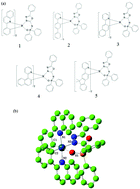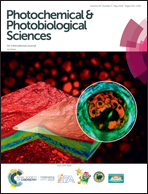Theoretical insight into the photophysical properties of five phosphorescent heteroleptic iridium(iii) complexes bearing oxadiazol-substituted amide ligands†
Abstract
A DFT/TDDFT (density functional theory/time-dependent density functional theory) investigation on the geometries in the ground and lowest triplet excited states, the frontier molecular orbitals, the absorption spectra and the phosphorescent emission properties of five heteroleptic iridium(III) complexes have been performed to obtain a better understanding of structure–property relationships. The key aim was to investigate the effect of π-conjugation on the photophysical properties of these studied complexes. The lowest energy absorption wavelengths are located at 461 nm for 1, 418 nm for 2, 422 nm for 3, 426 nm for 4 and 417 nm for 5. The lowest energy emissions of complexes 1–5 are localized at 572, 463, 583, 707 and 553 nm, respectively, simulated in acetonitrile medium at M052X level. These findings could be useful to provide good guidance for the further design of new potential phosphorescent organic light-emitting diode (OLED) materials.



 Please wait while we load your content...
Please wait while we load your content...